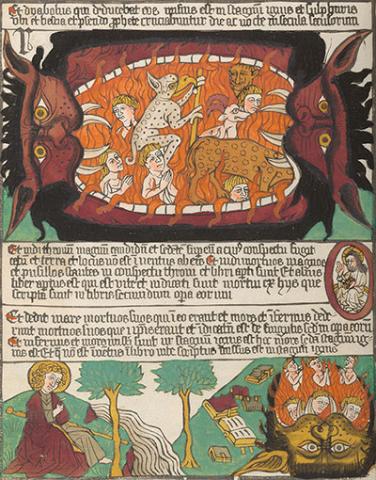
A blockbook is a genre of late-medieval book produced entirely from woodcuts, where the text and image are carved together into a wooden block and printed. Blockbooks are typically printed on one side of the paper only. This is due to the fact that printing was accomplished by placing the paper onto the woodblock and then rubbing the paper so that the ink would transfer from the wood to paper. This produced an embossed impression of the woodcut on the blank side of the sheet. Because of this rubbing process, both sides of the sheet could not be printed. The ease and speed of printing a blockbook allowed them to be produced to order, the first print-on-demand books. Interestingly, the printed sheets could be used like posters, mounted to a board or wall, for public display, or they could be folded in half and bound into book format for personal use.
There are about ten different editions of the Apocalypse blockbook, which were produced in the Netherlands in the 1460s and Germany in the 1460s–1480s. The Netherlandish examples derive from illuminated manuscripts produced in France and England in the 13th century, such as Morgan M.524, after which the compositions disseminated up the Rhine River into Germany. Each edition was produced from a unique set of woodblocks.
PML 8 belongs to a group of copies identified as Schreiber’s Edition V, the woodblocks for which were produced in Germany (perhaps around Mainz or Strasbourg) about 1468 and copies were printed from those blocks until about 1475. The Morgan copy is incomplete, retaining only 32 of the 48 original leaves (12–14, 16, 21–48/F2–G2, H2, L1–ZZ2), with modern blank paper added to replace all of the missing leaves. One of these leaves is now at the British Library (IB.16), but the remainder of the missing leaves are currently unknown. In PML 8, leaves 22 (L2) and 23 (M1) were transposed in printing, as is also seen in Bodleian Library copy (Auct. M 3.14).
Apocalypsis Sanctis Johannis. Germany, ca. 1470. Purchased with the Bennett collection, 1902. PML 8.
